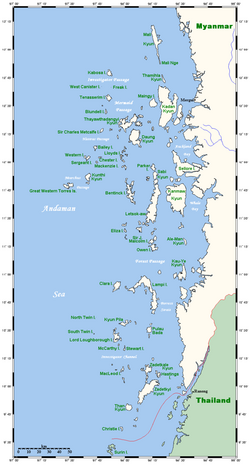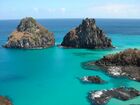Archipelago
Topic: Earth
 From HandWiki - Reading time: 4 min
From HandWiki - Reading time: 4 min


An archipelago (/ˌɑːrkəˈpɛləɡoʊ/ (![]() listen) AR-kə-PEL-ə-goh),[1] sometimes called an island group or island chain, is a chain, cluster, or collection of islands, or sometimes a sea containing a small number of scattered islands.
listen) AR-kə-PEL-ə-goh),[1] sometimes called an island group or island chain, is a chain, cluster, or collection of islands, or sometimes a sea containing a small number of scattered islands.
Examples of archipelagos include: the Indonesian Archipelago, the Andaman and Nicobar Islands, the Lakshadweep Islands, the Galápagos Islands, the Japanese archipelago, the Philippine Archipelago, the Maldives, the Balearic Islands, the Åland Islands, The Bahamas, the Aegean Islands, the Hawaiian Islands, the Canary Islands, Malta, the Azores, the Canadian Arctic Archipelago, the British Isles, the islands of the Archipelago Sea, and Shetland. Archipelagos are sometimes defined by political boundaries. For example, while they are geopolitically divided, the San Juan Islands and Gulf Islands geologically form part of a larger Gulf Archipelago.[2]
Etymology
The word archipelago is derived from the Ancient Greek ἄρχι-(arkhi-, "chief") and πέλαγος (pélagos, "sea") through the Italian arcipelago. In antiquity, "Archipelago" (from Medieval Greek *ἀρχιπέλαγος and Latin archipelagus) was the proper name for the Aegean Sea. Later, usage shifted to refer to the Aegean Islands (since the sea has a large number of islands).
Geographic types
Archipelagos may be found isolated in large amounts of water or neighbouring a large land mass. For example, Scotland has more than 700 islands surrounding its mainland, which form an archipelago.
Archipelagos are often volcanic, forming along island arcs generated by subduction zones or hotspots, but may also be the result of erosion, deposition, and land elevation. Depending on their geological origin, islands forming archipelagos can be referred to as oceanic islands, continental fragments, or continental islands.[3]
Oceanic islands
Oceanic islands are mainly of volcanic origin, and widely separated from any adjacent continent. The Hawaiian Islands and Galapagos Islands in the Pacific, and Mascarene Islands in the south Indian Ocean are examples.
Continental fragments
Continental fragments correspond to land masses that have separated from a continental mass due to tectonic displacement. The Farallon Islands off the coast of California are an example.
Continental archipelagos
Sets of islands formed close to the coast of a continent are considered continental archipelagos when they form part of the same continental shelf, when those islands are above-water extensions of the shelf. The islands of the Inside Passage off the coast of British Columbia and the Canadian Arctic Archipelago are examples.
Artificial archipelagos
Artificial archipelagos have been created in various countries for different purposes. Palm Islands and The World Islands off Dubai were or are being created for leisure and tourism purposes.[4][5] Marker Wadden in the Netherlands is being built as a conservation area for birds and other wildlife.[6]
Superlatives
The largest archipelago in the world by number of islands is the Archipelago Sea, which is part of Finland . There are approximately 40,000, mostly uninhabited, islands [7]
The largest archipelagic state in the world by area, and by population, is Indonesia.[8]
See also
- Island arc
- List of landforms
- List of archipelagos by number of islands
- List of archipelagos
- Archipelagic state
- List of islands
- Aquapelago
References
- ↑ "archipelago". Dictionary.com Unabridged. Random House. https://www.dictionary.com/browse/archipelago.
- ↑ "What is an archipelago?". https://oceanservice.noaa.gov/facts/archipelago.html.
- ↑ Whittaker R. J. & Fernández-Palacios J. M. (2007) Island Biogeography: Ecology, Evolution, and Conservation. New York, Oxford University Press
- ↑ McFadden, Christopher (22 December 2019). "7+ Amazing Facts About Dubai's Palm Islands". https://interestingengineering.com/7-curious-facts-about-dubais-palm-islands.
- ↑ Wainwright, Oliver (13 February 2018). "Not the end of The World: the return of Dubai's ultimate folly". http://www.theguardian.com/cities/2018/feb/13/not-end-the-world-return-dubai-ultimate-folly.
- ↑ Boffey, Daniel (27 April 2019). "Marker Wadden, the manmade Dutch archipelago where wild birds reign supreme". http://www.theguardian.com/world/2019/apr/27/marker-wadden-islands-netherlands-manmade-archipelago-wild-birds-eco-haven.
- ↑ "Nautical chart: International no. 1205, SE61, Baltic Sea, North, Sea of Åland.". http://www.sjofartsverket.se/upload/378/Sjokortsbilder/61.pdf.
- ↑ Template:Cite CIA World Factbook
External links
 |
 KSF
KSF

